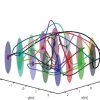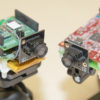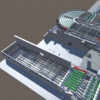This undergraduate lecture introduces the fundamentals of the design of digital circuits. Topics include Boolean algebra, combinatorial circuits, arithmetic circuits, flip flops, sequential circuits, memory systems, and computer architecture basics. The lecture is held in English in the summer term, primarily for the Bachelor program “Robotics and Artificial Intelligence“. A German version of this lecture is offered for the study program “Informationstechnik” in the winter term.
Objectives and Method
The lecture Design of Digital Circuits provides the student with essential basic knowledge and terminology for digital systems and provides methods for the analysis and design of digital circuits. It is a mandatory lecture of the bachelor program “Robotics and Artificial Intelligence” and is scheduled for the second semester. A German version is offered as part of the introductory orientation phase (STEOP) of the bachelor program “Informationstechnik” in the first semester.
For the exact schedule, please refer to the university’s campus system.
The lecture is structured in 11 chapters:
- Introduction
- Number Systems und Codes
- Boolean Algebra
- Combinational Logic
- Simplification of Logic Circuits
- Combinational Functional Blocks
- Arithmetic Combinational Logic
- Sequential Logic
- Standard Sequential Circuits
- Memory
- Microprocessor Basics
The lecture follows a “bottom-up design principle”, in which more complex circuits are realized with the help of simpler (and already known) components. Particular emphasis is placed on teaching methods for modeling and designing digital circuits. These methods cover number systems, logic, set theory, algebra, and finite state machines and are introduced accordingly. As a fundamental teaching objective after completing the lecture, students should be able to explain a simple processor’s structure and functioning and analyze and design the necessary components (sequential logic and combinational logic).
A separate two-hour course (KS) and a student tutorial (TU) complement the lecture and offer the opportunity to deepen the methods discussed in the lecture. Furthermore, the course covers the design of simple digital circuits and the analysis of the circuit’s functionality with the help of the Logisim simulation environment. The installation and use of the simulation environment will be discussed in the course.
Lecture Material
The lecture material on this website is password-protected and contain slides and exercise sheets for self-evaluation. You will receive the password at the beginning of the lecture. Solutions of the exercise sheets will not be checked. During the lecture, selected examples will be discussed. Short videos explain how selected digital circuits work using the Logisim simulation environment.
Tip: Solve the exercises on the exercise sheets alone or in a study group during the semester. This helps to consolidate your knowledge and prepare you well for the exam.
The lecture is accompanied by the following textbook:
Morris Mano, Charles R. Kime, Tom Martin. Logic and Computer Design Fundamentals. Pearson, 2016.
Several copies are available in the university library.
Code of Conduct (PDF) for studies of the Faculty of Technical Sciences.
Content and Organization (PDF) provides an overview of the lecture’s content and organization.
Exam
The assessment is based on a 90-minutes written exam. Three exam dates will be offered for each semester.
- Example exam 1 (PDF)
- Example exam 2 (PDF)
- The following document about the microprocessors (Chapter 11) will be provided for the exam: ExamSupplement (PDF). No other documents are allowed.
Contents
1. Introduction
History of computing machines; introduction of digital circuits
A series of articles on major developments in computer technology over the last 75 years (from the magazine “Computer”):
- Kshetri, Voas, Sharma. Computing and Socioeconomic Transformations. Computer, 54(2):26-29, 2021.
- Kshetri, Voas. Major Computing Technologies of the Past 75 Years. Computer, 54(5):15-21, 2021.
The well-known magazine Science has published a special issue to mark the 75th anniversary of the invention of the transistor. It also contains a critical editorial on William Shockley, who, together with John Bardeen and Walter Brattain, received the 1956 Nobel Prize in Physics for this invention.
2. Number Systems and Codes
Number representation; codes and codierung; binary arithmetic
3. Boolean Algebra
Circuits and truth tables; Boolean algebra; standard forms
4. Combinational Logic
Logic gates; synthesis of digital circuits; temporal behavior
[Projectfile for Logisim-evolution: Schaltnetz1.circ (save as file)]
5. Simplification of Logic Circuits
Minimization objectives; K-maps
6. Combinational Functional Blocks
Multiplexer and demultiplexer; programmable logic devices
7. Arithmetic Combinational Circuits
Adder; subtractor; multiplier
[Project file for Logisim-evolution: Statusbits.circ (save as file)]
8. Sequential Logic
Storage elements; finite state machines; design of sequential logic; analysis of sequential logic
[Project file for Logisim-evolution: Ampelsteuerung.circ (save as file)]
9. Standard Sequential Circuits
Registers; register transfer and micro-operations; counter
[Project file for Logisim-evolution: Zaehler.circ (save as file)]
10. Memory
Memory basics; SRAM; DRAM; flash-memory and hard disc drives
11. Microprocessor Basics
Von-Neumann architecture; model processor; time behavior









